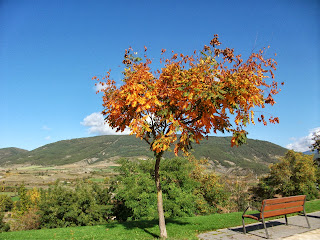I wrote this years ago and never published it.
The
Spanish take their festivals very seriously; none more so than the Aragonese.
Their
autumn
holiday dedicated to the little statue of the Virgin Mary on a pillar is when
the
city of
Zaragoza really is seen at its best. Giants parade the streets: every village
or town
in Spain
has some of these three metre tall human
frames made of papier maché. They
are
carried by strong men hidden in the long robes or skirts of the kings and
queens.
Common
they may be, but little children still stare and gasp. Their more comic
counterparts,
the “cabezudos” (bigheads) run amok, chasing and throwing sweets.
There are
funfairs, circuses with lions and tigers. Folk groups come from all over the
region.
They have been practising for weeks, with the heavy thumps of dance steps on
board
floors and the wailing voices of singers sounding far later into the night than
usual.
The
“Offering” to the diminutive “Virgin of the Pillar” is central to the festival.
She is
brought
out of her basilica into the square to receive the floral tribute. Thousands of
devotees
fill the streets of the city centre. There is a pervading smell of mothballs,
because
for this special day only, many people
wear regional costumes.
They take
their folk-finery out of storage and wear it to take part in laying the great
pyramid
of flowers before the city’s patroness. Men tie the emblematic red or purple
“cachirulo”
round their brows. They wear knee-breeches and wide sashes. Women and
girls are
more colourful in full skirts and bright silk-fringed shawls. If the sun
shines, it
is all
very pretty, looking like a painting by Goya at his most bucolic. It is also
very
crowded.
Our neighbour, Fermín, tells me that he was literally carried along by the
crowds
once; swept bodily into the basilica square.
This kind
of festivity, however, is not to everyone’s taste. If you do not feel inclined
to
dress up
and push, there is an alternative; one which is just as traditional. In the
days
before
the holiday, people ask:
“Are you
going down to Zaragoza, or the country?”
This year
we opted for the latter, as many others do. Luckily, Aragón has enough space
to spread
out in. We drove to the beautiful valley of Zuriza. Our object was to see the
autumn
colours. Zuriza has slopes of mixed forest, going down to a winding river. In
the open
spaces cattle grazed: bulls, cows, and calves which looked almost new-born.
They took
no notice of us. Here and there, a car or van stood by the trackside. Near one
of these
I looked up the slope of the hill and saw a man. He had a big knife in his
hand,
which he
hid when he noticed us. It seemed rather sinister until we realised:
“He’s
hunting for mushrooms!”
In this
part of the country, collecting fungi is popular. The locals say that
outsiders,
usually
from neighbouring Catalonia, come and fill vans with these wild delicacies. You
can sense
the resentment towards the wealthier “forasteros”, who take what nature gives
freely,
and sell it in their marketplaces. Many villages have what has to be translated
as
a
“municipal toadstool patch”, where the mushrooms are protected for the
residents to
pick,
having paid for a licence. Later, we saw a woman with a basket of golden fungi
poised on
her hip, but we were told that the weather had not been ideal. The best harvest
may be
yet to come.
Some
neighbours, nature lovers and intrepid mushroom gatherers, only managed to
find one
small basketful. Some dubious specimens had to be left behind. There is a
centre in
our Pyrenean town of Jaca, where you can take your finds to be identified by
experts.
Some people do not bother. Fermín told me of a family he knew who had made
a
mistake, and needed stomach- pumps all round. He added: “I know all the
different
species.
I won’t touch any of them!”
The
children found a patch of tall, white domes close to our house. I don’t know a
thing
about
edible fungi.
“Treasure!” said
Francisco, identifying them as “Coprinus comatus”.
“All for you!” I
replied. He cut half a dozen and came back for more
the next
day. Seeing that my neighbours were still alive, I cut the last one, fried and
ate
it before
I could change my mind. It tasted pretty good, almost good enough to make it
worth
going to the country to search for them.
Personally,
I would rather use my autumn holiday, not in the city crowds, nor with my
eyes on
the ground looking for the toadstool
harvest, but looking up at the red and gold
trees on
the hillsides, and the red kites and griffin vultures soaring overhead.
 After the French were turned out by the Spanish in 1813, he was able to return to Zaragoza from Cádiz, where he had fled, being crippled and unable to fight. He was honoured by the city he had given everything to defend.
After the French were turned out by the Spanish in 1813, he was able to return to Zaragoza from Cádiz, where he had fled, being crippled and unable to fight. He was honoured by the city he had given everything to defend.


.JPG)
.JPG)
.JPG)
.JPG)










































